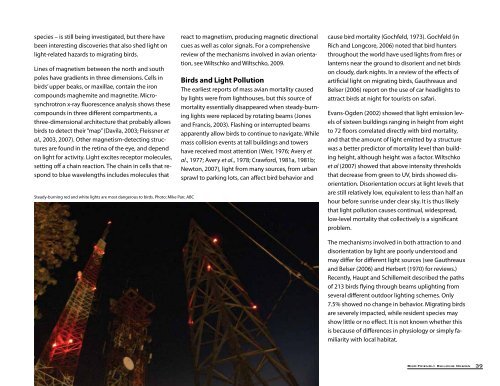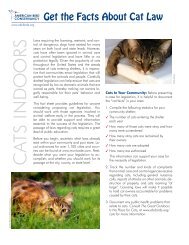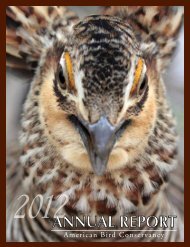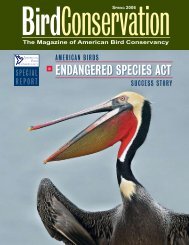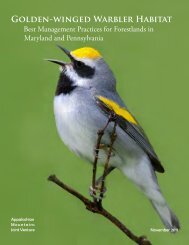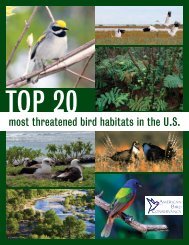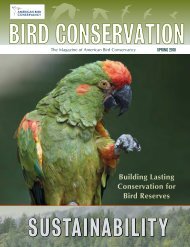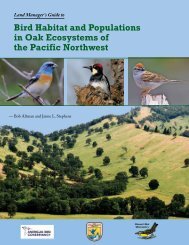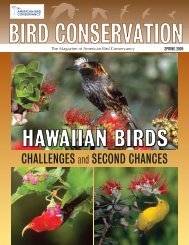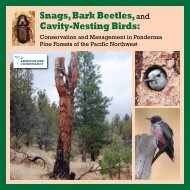Bird-Friendly Building Design Bird-Friendly Building Design
Bird-Friendly Building Design Bird-Friendly Building Design
Bird-Friendly Building Design Bird-Friendly Building Design
Create successful ePaper yourself
Turn your PDF publications into a flip-book with our unique Google optimized e-Paper software.
species – is still being investigated, but there havebeen interesting discoveries that also shed light onlight-related hazards to migrating birds.Lines of magnetism between the north and southpoles have gradients in three dimensions. Cells inbirds’ upper beaks, or maxillae, contain the ironcompounds maghemite and magnetite. Microsynchrotronx-ray fluorescence analysis shows thesecompounds in three different compartments, athree-dimensional architecture that probably allowsbirds to detect their “map” (Davila, 2003; Fleissner etal., 2003, 2007). Other magnetism-detecting structuresare found in the retina of the eye, and dependon light for activity. Light excites receptor molecules,setting off a chain reaction. The chain in cells that respondto blue wavelengths includes molecules thatSteady-burning red and white lights are most dangerous to birds. Photo: Mike Parr, ABCreact to magnetism, producing magnetic directionalcues as well as color signals. For a comprehensivereview of the mechanisms involved in avian orientation,see Wiltschko and Wiltschko, 2009.<strong>Bird</strong>s and Light PollutionThe earliest reports of mass avian mortality causedby lights were from lighthouses, but this source ofmortality essentially disappeared when steady-burninglights were replaced by rotating beams (Jonesand Francis, 2003). Flashing or interrupted beamsapparently allow birds to continue to navigate. Whilemass collision events at tall buildings and towershave received most attention (Weir, 1976; Avery etal., 1977; Avery et al., 1978; Crawford, 1981a, 1981b;Newton, 2007), light from many sources, from urbansprawl to parking lots, can affect bird behavior andcause bird mortality (Gochfeld, 1973). Gochfeld (inRich and Longcore, 2006) noted that bird huntersthroughout the world have used lights from fires orlanterns near the ground to disorient and net birdson cloudy, dark nights. In a review of the effects ofartificial light on migrating birds, Gauthreaux andBelser (2006) report on the use of car headlights toattract birds at night for tourists on safari.Evans-Ogden (2002) showed that light emission levelsof sixteen buildings ranging in height from eightto 72 floors correlated directly with bird mortality,and that the amount of light emitted by a structurewas a better predictor of mortality level than buildingheight, although height was a factor. Wiltschkoet al (2007) showed that above intensity thresholdsthat decrease from green to UV, birds showed disorientation.Disorientation occurs at light levels thatare still relatively low, equivalent to less than half anhour before sunrise under clear sky. It is thus likelythat light pollution causes continual, widespread,low-level mortality that collectively is a significantproblem.The mechanisms involved in both attraction to anddisorientation by light are poorly understood andmay differ for different light sources (see Gauthreauxand Belser (2006) and Herbert (1970) for reviews.)Recently, Haupt and Schillemeit described the pathsof 213 birds flying through beams uplighting fromseveral different outdoor lighting schemes. Only7.5% showed no change in behavior. Migrating birdsare severely impacted, while resident species mayshow little or no effect. It is not known whether thisis because of differences in physiology or simply familiaritywith local habitat.<strong>Bird</strong>-<strong>Friendly</strong> <strong>Building</strong> <strong>Design</strong>39


